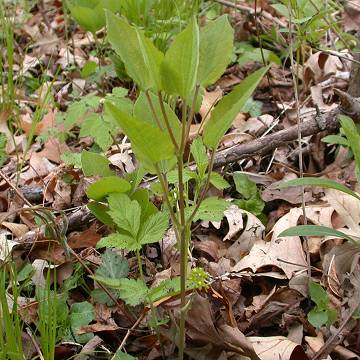

Smilax ecirrata - (image 1 of 7)
Taxonomy
Family: Smilacaceae
Habitat
Rich woods and thickets.
Associates
Allium tricoccum burdickii, Claytonia virginica, Crytotaenia canadensis, Galium aparine, Geranium maculatum, Hydrophyllum virginianum, Podophyllum peltatum, Polygonatum canaliculatum, Ranunculus abortivus, Ranunculus septentrionalis, Sanicula gregaria, Viola sororia.
Distribution
MI west to MN, south to KY, MO, and eastern OK.
Morphology
Herbaceous perennial to about 30" high; unbranched, without thorns. Tendrils usually lacking or only produced in upper leaf axils. Leaves few, often only 7-9, crowded on the upper part of the stem, narrowly to broadly ovate, truncate to cordate at base, convexly narrowed to a short cusp, hairy beneath. Flowers greenish; peduncles axillary to lance-linear bracts on the leafless lower part of the stem, or rarely also from the axil of the lowest leaf. Inflorescence ascending, to 4" long, seldom with more than 25 flowers. Fruit a berry with 3-5 seeds.
Notes
Flowers mid April to late May
Wetland indicator: Upland
The flowers are dioecious, with male and female flowers on separate plants. This is noticeable in the pictures.
References
Gleason, Henry A. and A. Cronquist. 1991. Manual of Vascular Plants of
Northeastern United States
and Adjacent Canada. Second Ed.
The New York Botanical Garden. Bronx, NY
Swink, F. and G. Wilhelm. 1994. Plants of the Chicago Region.
Indiana Academy of Science. The Morton Arboretum. Lisle, Illinois.
|
Michael Hough © 2005 |